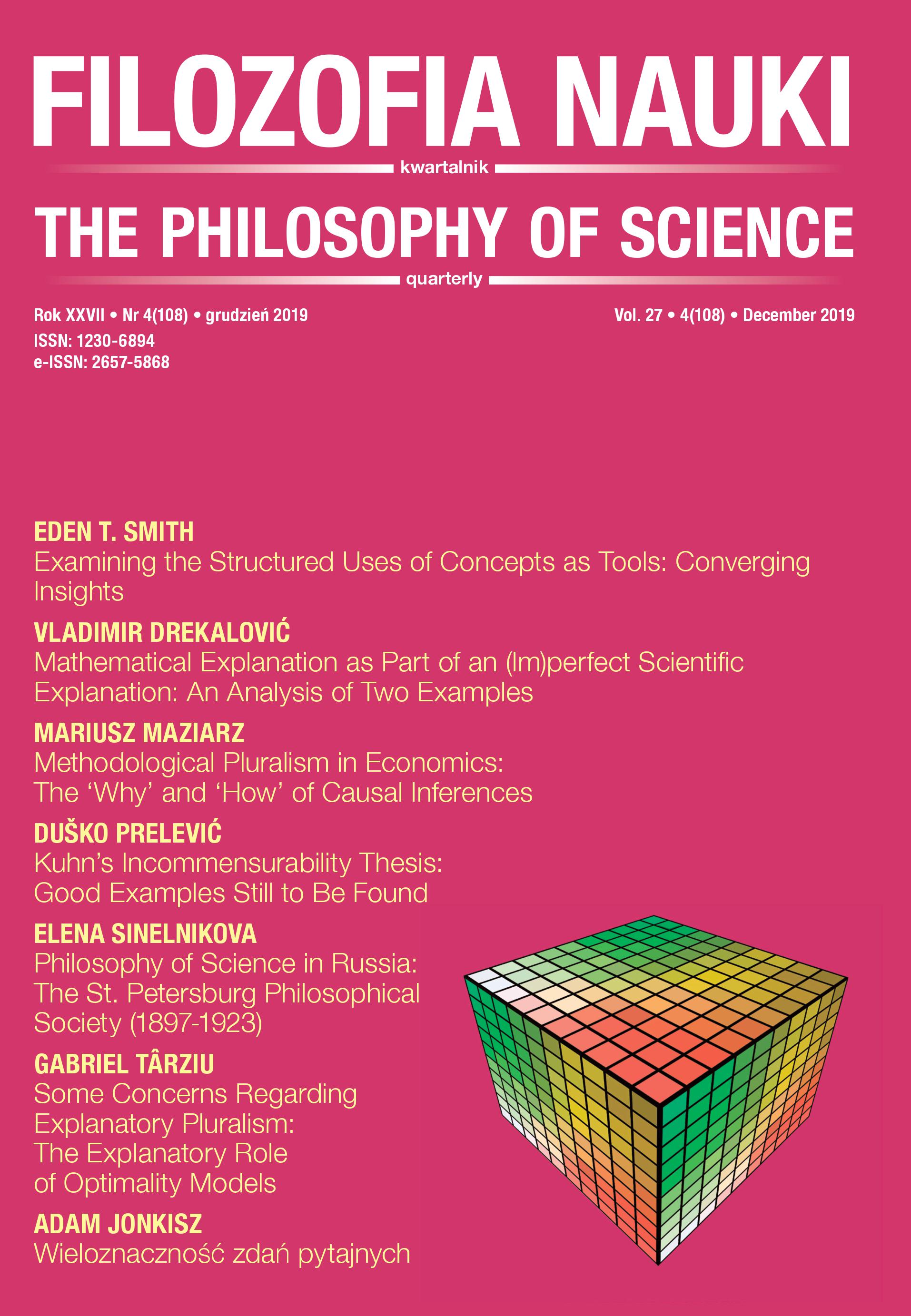Kuhn’s Incommensurability Thesis: Good Examples Still to Be Found
DOI:
https://doi.org/10.14394/filnau.2019.0026Słowa kluczowe:
Thomas Kuhn, niewspółpiernośćAbstrakt
In The Structure of Scientific Revolutions, Thomas Kuhn famously argued that scientific revolutions consist in paradigm shifts in which the superseded and the new paradigms are incommensurable. My aim in this paper is to show that neither Kuhn’s examples nor Yafeng Shan’s recently proposed example adequately support this incommensurability thesis. Starting from the distinction between global and local incommensurability, I argue that, on the one hand, local incommensurability does not imply that paradigms are globally incommensurable, and, on the other, that it is likely that real support for Kuhn’s thesis that “the proponents of competing paradigms practice their trades in different worlds” requires global incommensurabilities. Thus, I argue that the Kuhnian view is not capable of providing satisfactory evidence that those incommensurabilities ever occurred in the history of science.
Bibliografia
Bird A. (2004a), “Kuhn, Naturalism, and the Positivist Legacy,” Studies in History and Philosophy of Science 35, 337-356. https://doi.org/10.1016/j.shpsa.2004.01.001
Bird A. (2004b), “Kuhn on Reference and Essence,” Philosophia Scientiae 8, 39-71. https://doi.org/10.4000/philosophiascientiae.588
Birkhoff G., von Neumann J. (1936), “The Logic of Quantum Mechanics,” The Annals of Mathematics 37, 823-843. https://doi.org/10.2307/1968621
Carrier M. (2011), “Underdetermination as an Epistemological Test-Tube: Expounding Hidden Values of the Scientific Community,” Synthese 180, 189-204. https://doi.org/10.1007/s11229-009-9597-6
Chalmers D. (1996), The Conscious Mind, Oxford: Oxford University Press.
Chen X. (1997), “Thomas Kuhn’s Latest Notion of Incommensurability,” Journal for General Philosophy of Science 28, 257-273. https://doi.org/10.1023/A:1008220212003
Churchland P. (1986), Neurophilosophy, Cambridge, MA: MIT Press.
Churchland P. (1996), “The Rediscovery of the Light,” The Journal of Philosophy 93, 211-228. https://doi.org/10.2307/2940998
Darrigol O. (2012), A History of Optics: From Greek Antiquity to the Nineteenth Century, Oxford: Oxford University Press.
Darwin C. (1859), On the Origin of Species, London: John Murray.
Darwin C. (2008), C. Darwin to A. R. Wallace, February 6, 1866 [in:] Evolution: Selected Letters of Charles Darwin, Cambridge: Cambridge University Press.
Dawkins R. (2004), A Devil’s Chaplain: Reflections on Hope, Lies, Science, and Love, Boston–New York: Mariner Books.
Dennett D. (1991), Consciousness Explained, Boston: Little, Brown, and Co.
Duhem P. (1906), The Aim and the Structure of Physical Theory, New York: Atheneum.
Einstein A. (2008), “Geometry and Experience” [in:] Illuminated Geometry: Sidelights on Relativity, Walnut, CA: Mt. San Antonio College, 15-34.
Farley J., Geison G. (1974), “Science, Politics, and Spontaneous Generation in Nineteenth-Century France: The Pasteur–Pouchet Debate,” Bulletin of the History of Medicine 48, 161-198.
Fisher R. A. (1930), The Genetical Theory of Natural Selection, Oxford: Clarendon Press.
Frege G. (1960), On Sense and Reference [in:] Translations from the Philosophical Writings of Gottlob Frege, 2nd ed., P. Geach, M. Black (eds.), Oxford: Basil Blackwell, 56-78.
Friedman M. (2001), Dynamics of Reason, Stanford: Center for the Study of Language and Information.
Gayon J. (2016), “From Mendel to Epigenetics: History of Genetics,” Compted Rendus Biologies 339, 225-230. https://doi.org/10.1016/j.crvi.2016.05.009
Geison G. (1995), The Private Science of Louis Pasteur, Princeton: Princeton University Press.
Goldberg N. (2009), “Universal and Relative Rationality,” Principia 13, 67-84. https://doi.org/10.5007/1808-1711.2009v13n1p67
Howard D. (2005), “Albert Einstein as a Philosopher of Science,” Physics Today 58, 34-40. https://doi.org/10.1063/1.2169442
Hoyningen-Huene P. (1990), “Kuhn’s Conception of Incommensurability,” Studies in History and Philosophy of Science 21, 481-492. https://doi.org/10.1016/0039-3681(90) 90006-T
Jenkin H. C. F. (1867), “Review of The Origin of Species,” The North British Review 46, 277-318.
Kindi V., Arabatzis T. (eds.) (2012), Kuhn’s The Structure of Scientific Revolutions Revisited, New York–London: Routledge.
Kripke S. (1972), Naming and Necessity, Cambridge, MA: Harvard University Press.
Kuhn T. (1970), The Structure of Scientific Revolutions, 2nd ed., Chicago: The University of Chicago Press.
Kuhn T. (1982), “Commensurability, Comparability, Communicability,” PSA: Proceedings of the Biennial Meeting of the Philosophy of Science Association 1982, 2, 669-688. https://doi.org/10.1086/psaprocbienmeetp.1982.2.192452
Kuhn T. (1990a), “The Road since Structure,” PSA: Proceedings of the Biennial Meeting of the Philosophy of Science Association 1990, 2, 3-13. https://doi.org/10.1086/psaprocbienmeetp.1990.2.193054
Kuhn T. (1990b), Dubbing and Redubbing: The Vulnerability of Rigid Designation [in:] Minnesota Studies in the Philosophy of Science 14, C. Wade Savage, J. Conant, J. Haugeland (eds.), University of Minnesota Press, 298-318.
Kuhn T. (1993), Afterwords [in:] World Changes: Thomas Kuhn and the Nature of Science, P. Horwich (ed.), Cambridge, MA: MIT Press, 311-344.
Kuhn T. (2000a), Possible Worlds in History of Science [in:] The Road since Structure, J. Conant, J. Haugeland (eds.), Chicago: The University of Chicago Press, 58-89.
Kuhn T. (2000b), A Discussion with Thomas S. Kuhn (conducted by A. Baltas, K. Gavroglu, and V. Kindi in 1997) [in:] The Road since Structure, J. Conant, J. Haugeland (eds.), Chicago: The University of Chicago Press, 255-323.
Levine J. (1983), “Materialism and Qualia: The Explanatory Gap,” Pacific Philosophical Quarterly 64: 354-361. https://doi.org/10.1111/j.1468-0114.1983.tb00207.x
Łukasiewicz J. (1968), “On Determinism,” The Polish Review 13, 47-61.
Mizrahi M. (2015), “Kuhn’s Incommensurability Thesis: What’s the Argument,” Social Epistemology 29, 361-378. https://doi.org10.1080/02691728.2014.922635
Mizrahi M. (ed.) (2018), The Kuhnian Image of Science: Time for a Decisive Transformation?, London–New York: Rowman & Littlefield International.
Newton-Smith W. (1981), The Rationality of Science, London: Routledge & Kegan Paul.
Oberheim E., Hoyningen-Huene P. (2018), “The Incommensurability of Scientific Theories” [in:] Stanford Encyclopedia of Philosophy, E. N. Zalta (ed.), https://plato.stanford.edu/entries/incommensurability
Olby R. (1966), Origins of Mendelianism, London: Constable and Company Ltd.
Prelević D. (2017), “Hempel’s Dilemma and Research Programmes: Why Adding Stances Is Not a Boon,” Organon F 24, 487-510.
Putnam H. (1975), “The Meaning of ‘Meaning,’” Minnesota Studies in the Philosophy of Science 7, 131-193.
Read R., Sharrock W. (2002), “Thomas Kuhn’s Misunderstood Relation to Kripke–Putnam Essentialism,” Journal for General Philosophy of Science 33, 151-158. https://doi.org/10.1023/A:1020755503087
Reichenbach H. (1938), Experience and Prediction: An Analysis of the Foundations and the Structure of Knowledge, Chicago: The University of Chicago Press.
Richards R., Daston L. (eds.) (2016), Kuhn’s Structure of Scientific Revolutions at Fifty: Reflections on a Science Classic, Chicago–London: The University of Chicago Press.
Roll-Hansen N. (2018), “Revisiting the Pouchet—Pasteur Controversy over Spontaneous Generation: Understanding Experimental Method,” History and Philosophy of the Life Sciences 40(68), 1-28. https://doi.org/10.1007/s40656-018-0229-7
Rowbottom D. (2011), “Stances and Paradigms: A Reflection,” Synthese 178, 111-119. https://doi.org/10.1007/s11229-009-9524-x
Sandler I., Sandler L. (1985), “A Conceptual Ambiguity that Contributed to the Neglect of Mendel’s Paper,” History and Philosophy of Life Sciences 7, 3-70.
Sandler I., Sandler L. (1986), “On the Origin of Mendelian Genetics,” American Zoologist 26: 753-768.
Sandler J. (ed.) (1989), Projection, Identification, Projective Identification, London: Karnac Books.
Sankey H. (1993), “Kuhn’s Changing Concept of Incommensurability,” The British Journal for the Philosophy of Science 44, 759-744. https://doi.org/10.1093/bjps/44.4.759
Sankey H. (1998), “Taxonomic Incommensurability,” International Studies in the Philosophy of Science 12, 7-16. https://doi.org/10.1080/02698599808573578
Shan Y. (2018), “Kuhn’s ‘Wrong Turning’ and Legacy Today,” Synthese, 1-26. https://link.springer.com/article/10.1007/s11229-018-1740-9
Simmons L. (1994), “Three Kinds of Incommensurability Thesis,” American Philosophical Quarterly 31, 119-131.
Strick J. (2002), Sparks of Life: Darwinism and the Victorian Debates over Spontaneous Generation, Cambridge, MA–London: Harvard University Press.
Sturtevant A. H. (2001), A History of Genetics, New York: Cold Spring Harbor Laboratory Press & Electronic Scholarly Publishing Project.
van Fraassen B. (2002), The Empirical Stance, New Haven–London: Yale University Press.
Weinert F. (2009), Copernicus, Darwin, and Freud: Revolutions in the History and Philosophy of Science, Oxford: Wiley–Blackwell.



















 Filozofia Nauki | ISSN 1230-6894 | e-ISSN 2657-5868
Filozofia Nauki | ISSN 1230-6894 | e-ISSN 2657-5868